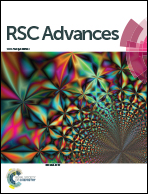Self-assembly of a hydrophobically end-capped charged amphiphilic triblock copolymer: effects of temperature and salinity†
Abstract
The association properties of aqueous solutions of the anionic thermo-responsive triblock terpolymer n-octadecyl-poly(ethylene glycol)-block-poly(N-isopropyl acrylamide)-block-poly(2-acrylamido-2-methyl-1-propanesulfonic sodium), abbreviated as C18-PEG10-b-PNIPAAM54-b-PAMPS10, have been studied as a function of temperature and salinity. This polymer exhibits a lower critical solution temperature (LCST) owing to its PNIPAAM block, and the presence of charges at the end of the chain influences the interaction properties. The effect of ionic strength was examined in detail by means of turbidimetry, zeta-sizer, dynamic light scattering, densitometry, and small angle neutron scattering (SANS). A temperature increase was seen to promote the formation of large aggregates in this system, with a strong dependency on the ionic strength of the solution. Increasing the ionic strength was found to give a large and controllable decrease in the cloud point (CP) due to screening of the electrostatic interactions. The hydrodynamic radius was found to drop significantly upon the addition of salt. At temperatures above CP, the intermicellar clusters observed by dynamic light scattering were found to contract. Furthermore, zeta-potential measurements demonstrated that charges were forced out towards the surface of the micellar structures with increasing temperature due to the strong dehydration effect of the associating PNIPAAM blocks.


 Please wait while we load your content...
Please wait while we load your content...